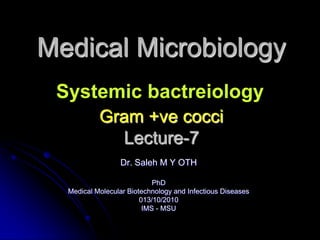
Microbiology lec6
- 1. Medical Microbiology Systemic bactreiology Gram +ve cocci Lecture-7 Dr. Saleh M Y OTH PhD Medical Molecular Biotechnology and Infectious Diseases 013/10/2010 IMS - MSU
- 2. Koch's postulates Sporatic disease Pathology Epidemiology Acute disease Etiology Chronic disease Infection Latent (recurrent) disease Disease Pathogen Local infection Invasiveness Systemic, generalized infection Opportunist Focal infection Reservoirs Primary infection Carrier Secondary infection Communicable (contagious) diseases Inapparent, subclinical infection Noncommunicable infectious diseases Nosocomial infections Direct contact transmission Bacteremia, viremia Indirect contact transmission Septicemia Fomite Toxemia Vectors Symptoms Droplet (nuclei) transmission Portal of entry Epidemic Portal of exit Pandemic Stages of disease: Endemic Incubation period Sporadic Disease Period of illness (invasive period) Convalescence 2
- 3. Streptococcus pneumoniae Pneumonia 3
- 4. - Causes 60-70% of all bacterial pneumonias - Small, lancet-shaped cells arranged in pairs and short chains - Culture requires blood or chocolate agar - Growth improved by 5-10% CO2 - Lack catalase and peroxidases – cultures die in O2 4
- 5. S. pneumoniae - All pathogenic strains form large capsules – major virulence factor - Specific soluble substance (SSS) varies among types - 90 different capsular types have been identified - Causes pneumonia and otitis media 5
- 6. Epidemiology and Pathology - 5-50% of all people carry it as normal flora in the nasopharynx; infections are usually endogenous - Very delicate, does not survive long outside of its habitat - Young children, elderly, immunocompromised, those with other lung diseases or viral infections, persons living in close quarters are predisposed to pneumonia - Pneumonia occurs when cells are aspirated into the lungs of susceptible individuals - Pneumococci multiply and induce an overwhelming inflammatory response - Gains access to middle ear by way of eustachian 6 tube
- 8. The course of bacterial pneumonia 8
- 9. View of ear anatomy indicating route of infection 9
- 10. Cultivation and Diagnosis - Gram stain of specimen – presumptive identification - Quellung test or capsular swelling reaction - α-hemolytic; optochin sensitivity, bile solubility, inulin fermentation 10
- 11. Treatment and Prevention Traditionally treated with penicillin G or V Increased drug resistance Two vaccines available for high risk individuals: - Capsular antigen vaccine for older adults and other high risk individuals – effective 5 years - Conjugate vaccine for children 2 to 23 months 11
- 12. Gram nigative cocci Family Neisseriaceae 12
- 13. Family Neisseriaceae Gram-negative cocci Residents of mucous membranes of warm- blooded animals Genera include Neisseria, Branhamella, Moraxella Two primary human pathogens: - Neisseria gonorrhoeae (STD) - Neisseria meningitidis 13
- 14. Genus Neisseria - Gram-negative, bean-shaped, diplococci - None develop flagella or spores - Capsules on pathogens - Pili - Strict parasites, do not survive long outside of the host - Aerobic or microaerophilic - Oxidative metabolism - Produce catalase and cytochrome oxidase - Pathogenic species require enriched complex media and CO2 14
- 15. Neisseria Gonorrhoeae: The Gonococcus Causes gonorrhea, an STD Virulence factors: - Fimbriae, other surface molecules for attachment; slows phagocytosis - IgA protease – cleaves secretory IgA 15
- 16. Epidemiology and Pathology - Strictly a human infection - In top 5 STDs - Infectious dose 100-1,000 - Does not survive more than 1-2 hours on fomites 16
- 17. Comparative incidence of reportable infectious STDs 17
- 18. Gonorrhea Infection is asymptomatic in 10% of males and 50% of females Males – urethritis, yellowish discharge, scarring, and infertility Females – vaginitis, urethritis, salpingitis (PID) mixed anaerobic abdominal infection, common cause of sterility and ectopic tubal pregnancies Extragenital infections – anal, pharygeal, conjunctivitis, septicemia, arthritis 18
- 19. Gonorrheal damage to the male reproductive tract 19
- 20. Ascending gonorrhea in women 20
- 21. Gonorrhea in Newborns Infected as they pass through birth canal Eye inflammation, blindness Prevented by prophylaxis immediately after birth 21
- 22. Diagnosis and Control Gram stain – Gram-negative intracellular (neutrophils) diplococci from urethral, vaginal, cervical, or eye exudate – presumptive identification 20-30% of new cases are penicillinase-producing PPNG or tetracycline resistant TRNG Combined therapies indicated Recurrent infections can occur Reportable infectious disease 22
- 23. Gram stain of urethral pus 23
- 24. Neisseria Meningitidis: The Meningococcus Virulence factors: - Capsule - Adhesive fimbriae - IgA protease - Endotoxin 12 strains; serotypes A, B, C cause most cases 24
- 25. Epidemiology and Pathogenesis Prevalent cause of meningitis; sporadic or epidemic Human reservoir – nasopharynx; 3-30% of adult population; higher in institutional settings High risk individuals are those living in close quarters, children 6 months-3 years, children and young adults 10-20 years 25
- 26. Epidemiology and Pathogenesis … Disease begins when bacteria enter bloodstream, cross the blood-brain barrier, permeate the meninges, and grow in the cerebrospinal fluid Very rapid onset; neurological symptoms; endotoxin causes hemorrhage and shock; can be fatal 26
- 27. Dissemination of the meningococcus from a nasopharyngeal infection 27
- 28. One clinical sign of meningococcemia 28
- 29. Clinical Diagnosis Gram stain CSF, blood, or asopharyngeal sample Culture for differentiation Rapid tests for capsular polysaccharide 29
- 30. Treatment and Prevention Treated with IV penicillin G, cephalosporin Prophylactic treatment of family members, medical personnel, or children in close contact with patient Primary vaccine contains specific purified capsular antigens 30
- 31. 31
- 32. Other Gram-Negative Cocci and Coccobacilli Genus Branhamella - Branhamella catarrhalis – found in nasopharynx: significant opportunist in cancer, diabetes, alcoholism Genus Moraxella - Bacilli – found on mucous membranes Genus Acinetobacter 32
